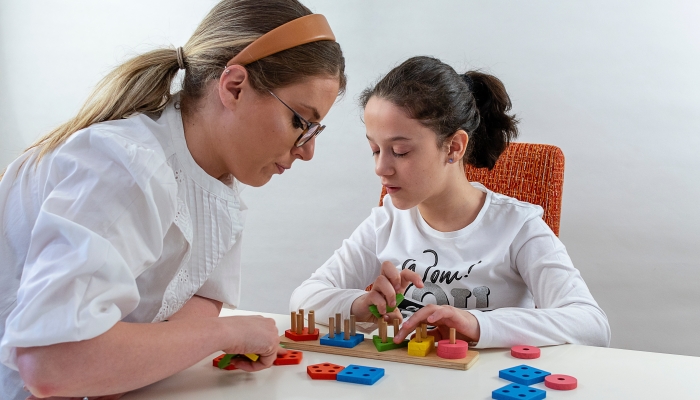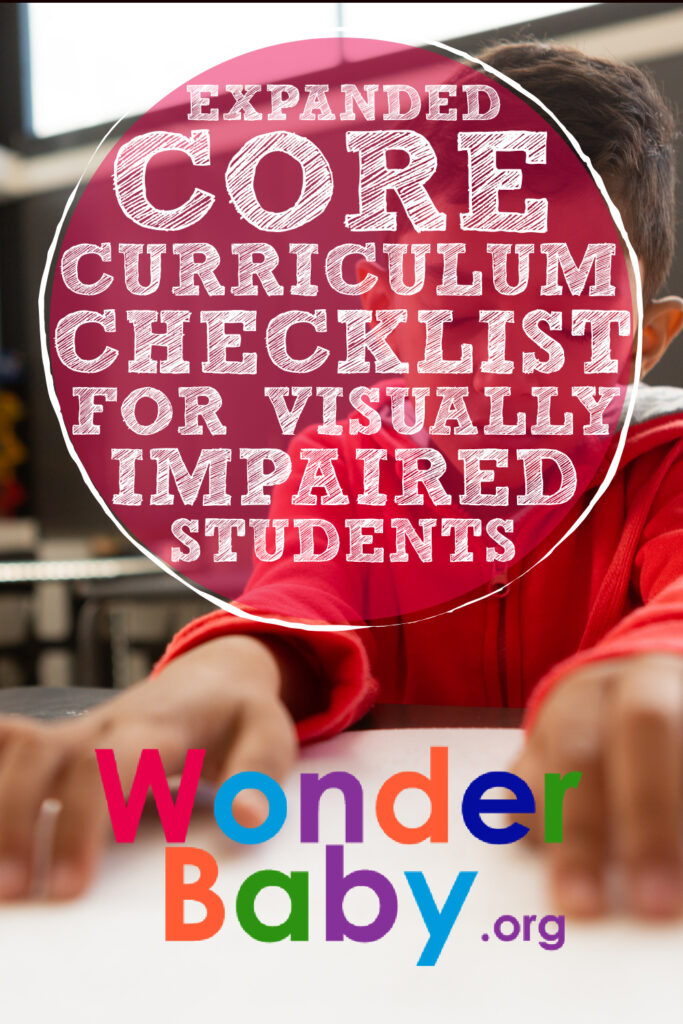Expanded Core Curriculum Checklist for Visually Impaired Students

- Visually impaired students face barriers to learning in a sighted classroom. They may face problems accessing the same information as their peers, struggle with collaborative tasks, or need assistive aids to help them learn.
- The ECC aims to level the playing field by improving educational access for students with visual impairments.
- Modifications can include technological devices, braille, and greater awareness of the difficulties facing students with visual impairments.
- The ECC covers skills that will aid visually impaired students in their studies and the life skills they will require for the future.
The Expanded Core Curriculum (ECC) is made up of nine components. The Expanded Core Curriculum for visually impaired students is a way of ensuring equality in the education system. It is intended to bridge the gap between the standard curriculum and what a visually impaired student might miss out on. The ECC can be life-changing for individuals. Students learn critical skills to aid independent living, academic success, and future employment.
Implementing the ECC allows students to gain the skills required to succeed in their studies and adulthood. Many lifelong skills are learned through observation, so it’s important to consciously teach these skills to students who may not have the opportunity to observe them otherwise.
ECC Components Checklist
The Expanded Core Curriculum (ECC) covers nine essential skill areas to complement the core academic curriculum.
1. Compensatory Skills or Functional Academic Skills

Students with visual impairment will benefit from skills to enhance their learning experience. Speaking and listening skills are of great importance in the classroom. Students should also learn tactile symbols, to read braille, and how to access recorded materials. Visually impaired students may also benefit from learning sign language.
Print reading and writing skills are important, too; large print materials give visually impaired students access to information. When learning to touch type, using tactile markers on the keyboard can help students with visual impairments.
When teaching math, for example, students can make tactile graphs during math lessons. The Expanded Core Curriculum provides the tools and learning so students can access the curriculum. For students with visual impairments, this means getting creative with tools and resources that allow students to learn alongside their peers.
2. Orientation and Mobility

Orientation skills are crucial for visually impaired people to move around safely. Orientation and mobility skills allow students to figure out where they are and how to move safely and independently. Students will need to develop skills such as learning to safely cross roads and take public transport. Students should be introduced to different mobility aids, such as white canes and guide dogs, so they can utilize tools that will allow them to move independently through the world.
Concept development can play an important role in orientation. If you walk into a classroom for the first time, your vision provides much information about your surroundings. Without that, students may not understand the layout or organization of the space. Ensure visually impaired students are given the opportunity to explore the classroom and make sense of their surroundings. Concept development is crucial to students with visual impairments as it helps them to make sense of their surroundings.
3. Social Interaction Skills

Social skills are an essential part of life. Most people learn social interaction skills by observing and copying people around them. Developing appropriate social skills can help people fit in and live fulfilling lives. Unfortunately, developing poor social skills can lead to isolation, so it’s crucial that visually impaired persons are given the chance to develop these necessary skills. A 2022 study on psychosocial adaptation among students with visual impairments11. Xie, Z., Yuan, W., & Zhang, L.. A cross-lagged study of psychosocial adaptation among students with visual impairments: Coping, self-esteem, and social integration. Research in Developmental Disabilities. 2022;128, 104292. https://doi.org/10.1016/j.ridd.2022.104292 found that social integration can impact self-esteem in students with visual impairments.
As part of the Expanded Core Curriculum, visually impaired students should learn communication skills, such as body language, gestures, and facial expressions. It’s also important to cover personal space and how to moderate interactions in different settings (work vs. social interactions, for example). Students should be taught how to participate actively as part of a group, a skill that will serve them well in the future. It’s also important to educate the other students in the class about the needs of students with visual impairments so they can build positive relationships with sighted peers and support one another in their learning journeys.
4. Independent Living Skills

To live independently, we need certain skills to succeed, and these are covered by the Expanded Core Curriculum. For example, money management skills are crucial for paying bills and budgeting. Food preparation is another key area students may need help with. Meal planning, grocery shopping, and cooking are important skills to teach. These skills are often picked up at home by observing parents, but for many visually impaired students, this kind of learning isn’t possible.
The ECC also covers clothing care, such as washing, drying, and ironing, to ensure students finish their studies with the ability to take care of their appearance. Personal hygiene skills also come under the ECC. Students should be taught to care for themselves to live independently.
5. Recreation and Leisure Skills

Leisure time is important for our mental health. Students with visual impairments should be given the opportunity to try out different leisure hobbies and pastimes. It’s important to offer a broad range of experiences so the student gets an idea of what activities they enjoy and what they may wish to carry on as a hobby. Team sports, board games, crafts, and fitness activities are good examples of recreation and leisure skills that students should be given the opportunity to try.
6. Career Education

The Expanded Core Curriculum includes a focus on workplace skills. This includes things like time management, organizational skills, prioritization skills, and knowing when to ask for help. As part of their career education, students should be encouraged to consider a wide range of career options. Students should consider their strengths and skills and explore career options.
Another important part of career education is learning about accessibility within the workplace. Learning about their workplace rights can boost confidence and prepare students for the future. Students should leave school with a decent career education that prepares them for their next steps in life.
7. Use of Assistive Technology

Assistive technology can be used to help students access the standard core curriculum. Students should have access to various assistive technology solutions and know how to select the right one for the task. Students should be taught how to use the program, care for the device, and ensure it is fully charged when needed.
Examples of assistive technologies include braille notetakers, voice command technology, talking calculators, apps for blind children, and video magnifiers. There are lots of different aids available, and it’s important to ensure students have access to a range of options. It’s also crucial to assess the assistive technologies on offer from time to time, as a student’s needs will vary over time.
Students should be taught how to use assistive technologies in everyday life. For example, teach students how to access, read, and reply to email correspondence. The Expanded Core Curriculum is not just about allowing students to access their education; it’s about ensuring they are set up with life skills for the future.
8. Sensory Efficiency Skills

When living with visual impairments, sensory efficiency can help you to understand the world around you. Students with residual vision should learn how to get the most out of the functional vision that they have. For example, vision aids may help them to examine objects in class where appropriate. Enhanced listening skills can benefit learning.
Include tasks that will improve listening skills, for example, asking students with visual impairments to locate noisy objects in the room. Once located, ask the student to explore the object with their hands and figure out what it is. It’s worthwhile to encourage students to regularly check in with their senses and see what information they hold about their surroundings. For example, smells and sounds hold clues about what activities may be taking place nearby.
9. Self-Determination
Self-determination skills are vital for empowering students. It’s important for students to advocate for themselves, not only during their studies but for the rest of their lives. Students should learn how to make decisions and set goals for themselves. It’s also crucial to teach coping strategies and emotional intelligence for when things don’t go according to plan.
Understanding the Needs of Visually Impaired Students
Teachers must understand the needs of each student in their classes, but as parents our job is to advocate for our children. The Expanded Core Curriculum aims to give students with visual impairments access to the same education as everybody else and provide a framework of expectations.

Unique Educational Needs
Students who are visually impaired may need modifications to access the same educational materials as the rest of the class. Your job as a parent is to advocate for accessibility so your visually impaired child has access to a good education.
The Role of ECC in Addressing These Needs
The Expanded Core Curriculum is designed to sit alongside the curriculum and provide the necessary modifications for students with visual impairments. The ECC highlights areas where students with visual impairments may struggle to access educational materials if modifications and aids are not in place. The ECC aims to ensure visually impaired students leave with as good an education as everybody else.
Thanks to the wide reach of the ECC, students with visual impairments should leave education with crucial life skills that will help them live a fulfilling life. Students will learn how to build and maintain fulfilling relationships, succeed in the workplace, take care of their health, and manage their finances. These skills are invaluable to all, especially those with visual impairments who may miss out on visually observing these skills in everyday life.
Implementing the ECC Checklist
Implementing the Expanded Core Curriculum checklist in a traditional classroom can be daunting. Here are some tips to help you understand and implement the checklist:

Tailor the ECC to the Child
The needs of your child will vary greatly depending on their age. Personal hygiene for a kindergartener, for example, will likely focus on hand washing, whereas a more comprehensive education will be needed for a sixteen-year-old.
If a student has multiple disabilities, you will need to take these into account when implementing the EEC in the classroom. Consult with both your child’s educational and healthcare team when developing the Expanded Core Curriculum in the classroom. How will your child’s other disabilities and educational needs impact access to the curriculum?
Assessing Student Progress
Implementing the Expanded Core Curriculum is not something you’ll do once; it’s an ongoing process that will continue as long as your child is in school. Continue to regularly reassess the situation to ensure you are meeting the requirements of the EEC. Stay in communication with the school and don’t hesitate to raise any issues or make suggestions that may benefit your child.
There are a number of assessment templates you can use to determine your child’s progress, like this Expanded Core Curriculum Needs Screening Tool22. Blankenship, K.. Expanded Core Curriculum Needs Screening Tool. Essential Assessments Rubric. 2009. https://earubric.com/expanded-core-curriculum-needs-screening-tool. This assessment tool covers all the main areas of the Expanded Core Curriculum and provides space for comments.
Resource and Training Availability
If this is your school’s first time implementing the ECC, it’s worthwhile asking for additional training first. Speak to your school district and ask whether your child’s staff can undertake training specific to the curriculum; this will equip them with the necessary knowledge and understanding to implement the EEC and give them access to an expert in the matter.
Do not be afraid to reach out for help. There are lots of resources and training materials, as well as checklists and case studies online and in print, so you can see how the ECC looks in practice. The following resources will give you a good understanding of the ECC:
- The Expanded Core Curriculum
- ECC Essentials: Teaching the Expanded Core Curriculum to Students with Visual Impairments
- CVI and the Expanded Core Curriculum (ECC)
References
- Xie, Z., Yuan, W., & Zhang, L. (2022). A cross-lagged study of psychosocial adaptation among students with visual impairments: Coping, self-esteem, and social integration. Research in Developmental Disabilities, 128, 104292. https://doi.org/10.1016/j.ridd.2022.104292
- Blankenship, K. (2009). Expanded Core Curriculum Needs Screening Tool. Essential Assessments Rubric. https://earubric.com/expanded-core-curriculum-needs-screening-tool

Related Posts

Eye Conditions and Syndromes, Visual Impairment
Neuralink Announces Plans to Restore Sight to the Blind with Brain Chip
Elon Musk’s company Neuralink has announced plans to begin human trials of its new “Blindsight” brain chip by the end of 2025.

IEPs
What Should I Bring to My Child’s First IEP Meeting?
Prepare for your child's first IEP meeting with confidence! Discover exactly what documents to bring, including educational records, medical info, and questions to ask.

Special Needs
5 Spring Cleaning Tips for Families of Children with Disabilities
Spring cleaning is an opportunity to create a more accessible, organized, and supportive space for your child with disabilities. Declutter, deep clean, and refresh!